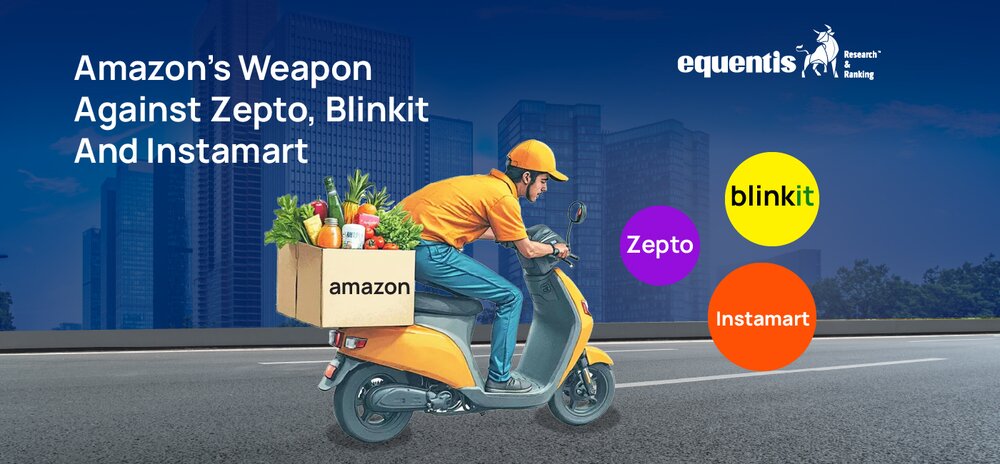In the bustling streets of India’s cities, a new kind of shopping experience has taken root: quick commerce, or Q-commerce. This model promises ultra-fast delivery of essentials, often within minutes, catering to the ever-increasing demand for speed and convenience.
Leading the charge are platforms like Blinkit, Zepto, and Swiggy Instamart. Now, global e-commerce titan Amazon is gearing up to challenge these players with its own secret weapon – “Amazon Now”.
Source: Economic Times
This move positions Amazon alongside rapid delivery services from companies like Zomato’s Blinkit and Swiggy’s Instamart, which offer deliveries as quickly as 10 minutes.
The Rise of Quick Commerce in India
India’s quick commerce industry has experienced extraordinary growth, with sales soaring by over 280% in the past two years, according to a report by financial services firm Chryseum. As of 2024, the sector was valued at USD 3.3 billion and is expected to expand significantly, reaching USD 9.95 billion by 2029.
This growth is driven by a compound annual growth rate (CAGR) of over 4.5% during the forecast period (2024-2029), which highlights the increasing consumer demand for ultra-fast delivery services.
Amazon’s Foray into Quick Commerce
Recognizing the potential of this growing market, Amazon initiated trials for its quick commerce service, ‘Amazon Now,’ in early 2024. The initial pilot was launched in Whitefield, Bengaluru—an area where Amazon enjoys high customer density, particularly among its Prime subscribers. The company set up four dark stores to manage local deliveries and soon scaled operations to 2,000 daily orders.
After laying the groundwork throughout 2024, and a limited launch in January-February, Amazon is now scaling up Amazon Now. The company plans to establish 300 dark stores across India’s top three cities—Delhi-NCR, Mumbai, and Bengaluru—by the end of 2025.
According to sources, the number of dark stores had grown to five by last week, with an immediate goal of reaching 100 stores within the next three to six months. Amazon’s next step will be expanding Amazon Now to more areas within Bengaluru.
Source: Economic Times/Business Standard
How Amazon’s Quick Commerce Model Works
The company’s quick commerce approach is similar to that of existing players. Each dark store caters to a 2-3 km radius, ensuring delivery within 10-15 minutes. The average order value is around INR 550, with a strong focus on grocery essentials—just like Blinkit, Zepto, and Instamart.
However, it has a unique advantage—its extensive Prime membership base. With an estimated 16-20 million Prime users in India, Amazon already has access to a massive pool of urban, convenience-driven shoppers. These users comprise over half of India’s 30 million quick-commerce buyers. Leveraging its vast data and AI capabilities, Amazon is poised to personalize and optimize its offerings better than its competitors. Source: Economic Times
The Power of Prime: Amazon’s Secret Weapon
Amazon’s Prime subscribers could be the key to its quick commerce success. In the Whitefield pilot, Amazon opened ‘Amazon Now’ access to only 1% of its Prime customers. Even at this limited scale, the results were promising. The giant’s quick commerce business could grow exponentially once the service expands to all Prime users.
Source: Economic Times
Changing Approach in India
Despite being one of the biggest brand names, it wasn’t all smooth sailing for Amazon, as the company faced its fair share of challenges. By mid-2024, Amazon reached a critical point in India, struggling with growing regulatory hurdles and a shifting political landscape.
The global e-commerce giant was forced to reassess its strategy—once known for its aggressive expansion, it adopted a more cautious approach. Regulatory changes compelled Amazon to distance itself from the large sellers it had previously depended on, resulting in layoffs and leadership reshuffles.
Despite these hurdles, Amazon pushed forward. It launched ‘Bazaar,’ a low-price merchandise business, to counter Meesho’s dominance in the unbranded, value-commerce space.
The Team Driving Growth Now
Amazon has assembled a top-tier team to lead its quick commerce division. To build this new business, Amazon aggressively hires across multiple functions, including planning, forecasting, customer acquisition, business analytics, and product management. Many hires are sourced from Amazon’s existing Grocery and Everyday Essentials teams.
Why Quick Commerce Now?
Amazon, like Flipkart and BigBasket, initially underestimated the quick commerce trend. The company viewed it as a passing phase, believing that traditional e-commerce with scheduled deliveries would remain dominant. However, as market leaders like Blinkit and Zepto scaled rapidly, Amazon realized it needed to adapt.
One of the reasons for Amazon’s slow entry was its decision-making structure. Unlike its startup-style competitors, Amazon India’s major business moves require approval from its Seattle headquarters. This resulted in a long lead time from conceptualization to execution. Despite this slow start, Amazon is now fully committed to catching up. thearcweb.com
The Competitive Landscape and Amazon’s Strategy
Amazon’s biggest challenge is that it is starting behind well-established players. Zomato Blinkit handles around 1.2 million daily orders, Zepto processes 1.1 million, Swiggy Instamart serves 900,000, and Tata BigBasket delivers 300,000. Flipkart, Amazon’s direct rival, has also entered quick commerce, crossing 100,000 orders per day.
What changed Amazon’s mind? Blinkit’s financial performance played a role. The company reported an adjusted EBITDA-positive quarter in March 2024, proving that quick commerce could be profitable. Blinkit posted INR 769 crore in revenue with a loss of just INR 37 crore for the January-March 2024 quarter, showing significant growth and improved unit economics.
Source: Economic Times
Amazon believes it has certain advantages that will help it succeed despite its late entry:
- Prime Subscriber Base – With millions of loyal Prime users, Amazon already has a built-in customer base for quick commerce.
- Tech and AI Capabilities – Amazon’s data-driven approach could improve inventory management and demand forecasting.
- Logistics Strength – While Amazon is a logistics powerhouse, it partnered with last-mile delivery firm LoadShare for quick commerce fulfillment.
- Focus on Urban Markets – Amazon expects a major shift in delivery preferences in metro cities, making quick commerce an essential part of its future strategy.
Looking Beyond India: Amazon’s Global Quick Commerce Plans
Interestingly, Amazon’s quick commerce expansion isn’t limited to India. The India team is also playing a role in developing similar operations in the UAE and Saudi Arabia. This suggests that Amazon sees quick commerce as a global opportunity, not just an Indian market trend.
Challenges Ahead
Despite its strengths, Amazon faces notable challenges in this competitive landscape:
- Established Competitors: Players like Blinkit, Zepto, and Swiggy Instamart have already captured substantial market share and have fine-tuned their operations to cater to local preferences.
- Operational Complexity: Quick commerce demands meticulous coordination between inventory management, order processing, and last-mile delivery. Ensuring seamless operations at scale will be a critical test for Amazon.
- Regulatory Environment: Navigating India’s regulatory landscape requires compliance with various laws and guidelines, necessitating a strategic approach to align with local regulations.
Can Amazon Win the Quick Commerce Race?
Amazon has already invested over $6.5 billion in India. With quick commerce gaining traction, it cannot afford to sit on the sidelines. The company is betting that the demand for instant deliveries will only grow, particularly in urban areas. However, success in this space will require rapid expansion, aggressive customer acquisition, and efficient operations.
The challenge? Competition is fierce, and Blinkit, Zepto, and Swiggy Instamart have a strong first-mover advantage. Amazon must scale quickly while ensuring profitability—something even established players struggle with.
Despite these hurdles, Amazon’s deep pockets, technological expertise, and loyal Prime user base could make it a formidable player in the quick commerce battle. If it executes its strategy well, Amazon Now could soon become a major contender in India’s instant delivery revolution.
Related Posts
Disclaimer Note: The securities quoted, if any, are for illustration only and are not recommendatory. This article is for education purposes only and shall not be considered as a recommendation or investment advice by Equentis – Research & Ranking. We will not be liable for any losses that may occur. Investments in the securities market are subject to market risks. Read all the related documents carefully before investing. Registration granted by SEBI, membership of BASL & the certification from NISM in no way guarantee performance of the intermediary or provide any assurance of returns to investors.
FAQ
What are Amazon’s dark stores?
They’re small, localized warehouses optimized for rapid delivery, not customer visits. Amazon uses them to fulfill quick commerce orders, competing with existing players.
Why is Amazon entering the quick commerce market?
The market’s projected $9.95 billion value by 2029 presents a significant growth opportunity. Amazon aims to capture a share by leveraging its logistics and reach.
How does Amazon’s strategy differ from existing quick commerce giants?
Amazon leverages its existing infrastructure and vast product selection, while others focus on hyper-local, limited assortments, and often, exclusive partnerships with local vendors.
What impact will Amazon’s entry have on the quick commerce market?
Increased competition, potentially driving down prices and improving delivery times. It could also consolidate the market, with Amazon’s scale posing a challenge to smaller players.
What does the $9.95 billion market projection signify?
It indicates strong consumer demand for ultra-fast delivery. This growth is driven by changing consumer habits and the increasing convenience of online shopping.
How useful was this post?
Click on a star to rate it!
Average rating 4.5 / 5. Vote count: 2
No votes so far! Be the first to rate this post.
I’m Archana R. Chettiar, an experienced content creator with
an affinity for writing on personal finance and other financial content. I
love to write on equity investing, retirement, managing money, and more.
- Archana Chettiar


















